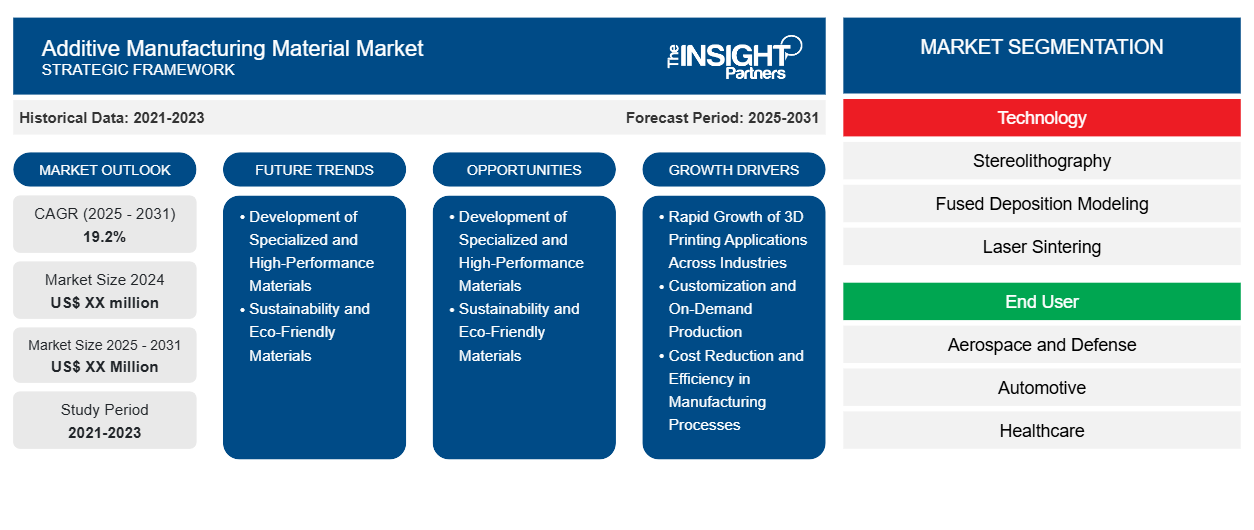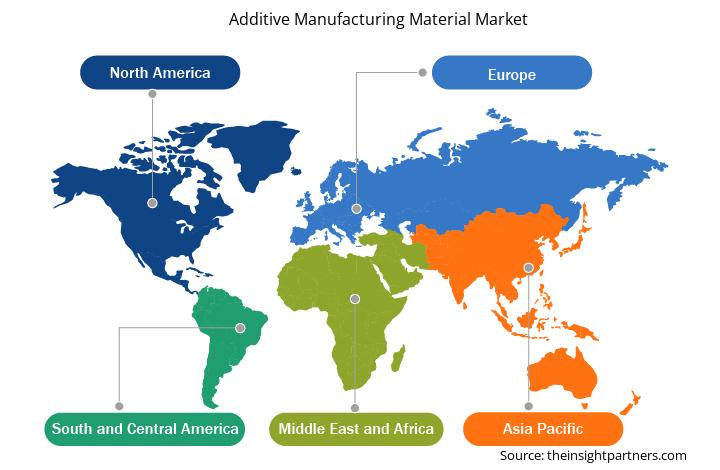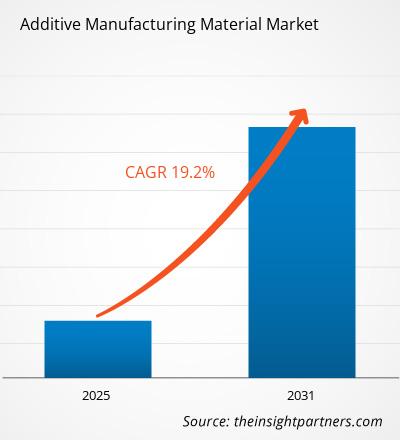Für den Markt für additive Fertigungsmaterialien wird von 2025 bis 2031 eine durchschnittliche jährliche Wachstumsrate (CAGR) von 19,2 % erwartet, wobei die Marktgröße von XX Millionen US-Dollar im Jahr 2024 auf XX Millionen US-Dollar im Jahr 2031 anwachsen wird.
Der Bericht ist segmentiert nach Technologie (Stereolithographie, Fused Deposition Modeling, Lasersintern und weitere Technologien), Endverbraucher (Luftfahrt und Verteidigung, Automobilindustrie, Gesundheitswesen, Industrie und weitere Endverbraucher) und Material (Kunststoff, Metalle und Keramik). Die globale Analyse wird weiter nach Regionen und wichtigen Ländern aufgeschlüsselt. Der Bericht bietet den Wert in USD für die oben genannten Analysen und Segmente.
Zweck des Berichts
Der Bericht „Additive Manufacturing Material Market“ von The Insight Partners beschreibt die aktuelle Marktsituation und das zukünftige Wachstum sowie die wichtigsten Treiber, Herausforderungen und Chancen. Er liefert Einblicke für verschiedene Geschäftsinteressenten, wie zum Beispiel:
- Technologieanbieter/-hersteller: Um die sich entwickelnde Marktdynamik zu verstehen und die potenziellen Wachstumschancen zu kennen, können sie fundierte strategische Entscheidungen treffen.
- Investoren: Um eine umfassende Trendanalyse hinsichtlich der Marktwachstumsrate, der finanziellen Marktprognosen und der Chancen entlang der Wertschöpfungskette durchzuführen.
- Regulierungsbehörden: Sie regulieren die Richtlinien und polizeilichen Aktivitäten auf dem Markt mit dem Ziel, Missbrauch zu minimieren, das Vertrauen der Anleger zu wahren und die Integrität und Stabilität des Marktes aufrechtzuerhalten.
Marktsegmentierung für additive Fertigungsmaterialien
Technologie
- Stereolithographie
- Fused Deposition Modeling
- Lasersintern
- Andere Technologien
Endbenutzer
- Luft- und Raumfahrt und Verteidigung
- Automobilindustrie
- Gesundheitspflege
- Industrielle und andere Endverbraucher
Material
- Plastik
- Metalle
- Keramik
Geographie
- Nordamerika
- Europa
- Asien-Pazifik
- Naher Osten und Afrika
- Süd- und Mittelamerika
Passen Sie diesen Bericht Ihren Anforderungen an
Sie erhalten kostenlos Anpassungen an jedem Bericht, einschließlich Teilen dieses Berichts oder einer Analyse auf Länderebene, eines Excel-Datenpakets sowie tolle Angebote und Rabatte für Start-ups und Universitäten
Markt für additive Fertigungsmaterialien: Strategische Einblicke

-
Informieren Sie sich über die wichtigsten Markttrends in diesem Bericht.Dieses KOSTENLOSE Beispiel umfasst Datenanalysen, von Markttrends bis hin zu Schätzungen und Prognosen.
Wachstumstreiber für den Markt für additive Fertigungsmaterialien
- Rasantes Wachstum von 3D-Druckanwendungen in verschiedenen Branchen: Der zunehmende Einsatz additiver Fertigung (AM) in verschiedenen Branchen, darunter Automobilindustrie, Luft- und Raumfahrt, Gesundheitswesen, Konsumgüterindustrie und Fertigung, treibt die Nachfrage nach speziellen 3D-Druckmaterialien voran. Diese Branchen benötigen Materialien mit einzigartigen Eigenschaften wie hoher Festigkeit, Flexibilität, Hitzebeständigkeit und Biokompatibilität, was den Markt für fortschrittliche AM-Materialien vorantreibt. Da immer mehr Branchen 3D-Druck für Prototyping, Produktion und kundenspezifische Designs einsetzen, wächst der Bedarf an einer vielfältigen Materialpalette weiter.
- Individualisierung und On-Demand-Produktion: Einer der Haupttreiber des Marktes für additive Fertigungsmaterialien ist die Nachfrage nach Individualisierung und On-Demand-Produktion. Additive Fertigung ermöglicht die Herstellung komplexer, hochgradig individualisierter Teile und Produkte mit minimalem Abfall. Diese Nachfrage ist besonders in Branchen wie dem Gesundheitswesen (für Prothesen und Implantate), der Modebranche (individuelle Accessoires) und der Luft- und Raumfahrt (individuelle Flugzeugteile) ausgeprägt. Die Möglichkeit, maßgeschneiderte Teile herzustellen, erhöht die Nachfrage nach einer Vielzahl von AM-Materialien. Kostensenkung und Effizienz in Fertigungsprozessen: Additive Fertigung bietet erhebliche Kosteneinsparungen gegenüber herkömmlichen Fertigungsverfahren, insbesondere bei Kleinserien und komplexen Geometrien. Sie reduziert Materialabfall, Werkzeugverschleiß und Arbeitskosten. Diese Effizienzvorteile haben zu einer verstärkten Nutzung von AM in Branchen geführt, die ihre Produktionskosten senken und ihre Betriebseffizienz steigern möchten. Mit der Weiterentwicklung der Technologie und der Diversifizierung der Materialoptionen setzen immer mehr Hersteller sowohl für die Prototypenentwicklung als auch für die Endproduktion auf den 3D-Druck, was den Markt für AM-Materialien weiter ankurbelt.
Zukünftige Trends auf dem Markt für additive Fertigungsmaterialien
- Entwicklung spezialisierter Hochleistungsmaterialien: Es gibt einen klaren Trend zur Entwicklung spezialisierter Hochleistungsmaterialien für spezifische Anwendungen. Beispielsweise setzen die Luft- und Raumfahrt sowie die Automobilindustrie zunehmend auf fortschrittliche Polymere, Metalllegierungen und Verbundwerkstoffe mit hervorragenden mechanischen Eigenschaften, hoher Hitzebeständigkeit und geringem Gewicht. Im Gesundheitswesen gewinnen biokompatible und biologisch abbaubare Materialien für 3D-gedruckte medizinische Geräte und Implantate an Beliebtheit. Mit der Weiterentwicklung der additiven Fertigung investieren immer mehr Branchen in Materialien, die ihren individuellen Leistungsanforderungen gerecht werden.
- Nachhaltigkeit und umweltfreundliche Materialien: Nachhaltigkeit ist ein wachsender Trend im Markt für additive Fertigungsmaterialien. Mit zunehmendem Umweltbewusstsein in Industrie und Verbrauchern steigt die Nachfrage nach umweltfreundlichen Materialien. Dazu gehört die Verwendung recycelbarer, biologisch abbaubarer oder emissionsarmer Materialien sowie die Entwicklung von Materialien aus erneuerbaren Ressourcen. Der Wunsch nach umweltfreundlicheren Lösungen in der Fertigung und der regulatorische Druck ermutigen Unternehmen, innovative nachhaltige Materialoptionen für den 3D-Druck zu entwickeln.eco-friendly materials. This includes the use of recyclable, biodegradable, or low-emission materials, as well as the development of materials from renewable resources. The drive for greener solutions in manufacturing, along with regulatory pressures, is encouraging companies to innovate in sustainable material options for 3D printing.
Marktchancen für additive Fertigungsmaterialien
- Entwicklung spezialisierter Hochleistungsmaterialien: Es gibt einen klaren Trend zur Entwicklung spezialisierter Hochleistungsmaterialien für spezifische Anwendungen. Beispielsweise setzen die Luft- und Raumfahrt sowie die Automobilindustrie zunehmend auf fortschrittliche Polymere, Metalllegierungen und Verbundwerkstoffe mit hervorragenden mechanischen Eigenschaften, hoher Hitzebeständigkeit und geringem Gewicht. Im Gesundheitswesen gewinnen biokompatible und biologisch abbaubare Materialien für 3D-gedruckte medizinische Geräte und Implantate an Beliebtheit. Mit der Weiterentwicklung der additiven Fertigung investieren immer mehr Branchen in Materialien, die ihren individuellen Leistungsanforderungen gerecht werden.
- Nachhaltigkeit und umweltfreundliche Materialien: Nachhaltigkeit ist ein wachsender Trend im Markt für additive Fertigungsmaterialien. Mit zunehmendem Umweltbewusstsein in Industrie und Verbrauchern steigt die Nachfrage nach umweltfreundlichen Materialien. Dazu gehört die Verwendung recycelbarer, biologisch abbaubarer oder emissionsarmer Materialien sowie die Entwicklung von Materialien aus erneuerbaren Ressourcen. Der Wunsch nach umweltfreundlicheren Lösungen in der Fertigung und der regulatorische Druck ermutigen Unternehmen, innovative nachhaltige Materialoptionen für den 3D-Druck zu entwickeln.
Regionale Einblicke in den Markt für additive Fertigungsmaterialien
Die Analysten von Insight Partners haben die regionalen Trends und Faktoren, die den Markt für additive Fertigungsmaterialien im Prognosezeitraum beeinflussen, ausführlich erläutert. In diesem Abschnitt werden auch die Marktsegmente und die geografische Lage von additiven Fertigungsmaterialien in Nordamerika, Europa, Asien-Pazifik, dem Nahen Osten und Afrika sowie Süd- und Mittelamerika erörtert.

- Erhalten Sie regionale Daten zum Markt für additive Fertigungsmaterialien
Umfang des Marktberichts über additive Fertigungsmaterialien
| Berichtsattribut | Details |
|---|---|
| Marktgröße im Jahr 2024 | XX Millionen US-Dollar |
| Marktgröße bis 2031 | XX Millionen US-Dollar |
| Globale CAGR (2025 – 2031) | 19,2 % |
| Historische Daten | 2021-2023 |
| Prognosezeitraum | 2025–2031 |
| Abgedeckte Segmente |
Nach Technologie
|
| Abgedeckte Regionen und Länder |
Nordamerika
|
| Marktführer und wichtige Unternehmensprofile |
|
Dichte der Marktteilnehmer für additive Fertigungsmaterialien: Verständnis ihrer Auswirkungen auf die Geschäftsdynamik
Der Markt für additive Fertigungsmaterialien wächst rasant. Dies wird durch die steigende Endverbrauchernachfrage aufgrund veränderter Verbraucherpräferenzen, technologischer Fortschritte und eines stärkeren Bewusstseins für die Produktvorteile vorangetrieben. Mit der steigenden Nachfrage erweitern Unternehmen ihr Angebot, entwickeln Innovationen, um den Verbraucherbedürfnissen gerecht zu werden, und nutzen neue Trends, was das Marktwachstum weiter ankurbelt.
Die Marktteilnehmerdichte beschreibt die Verteilung der in einem bestimmten Markt oder einer bestimmten Branche tätigen Unternehmen. Sie gibt an, wie viele Wettbewerber (Marktteilnehmer) in einem bestimmten Marktraum im Verhältnis zu dessen Größe oder Gesamtmarktwert präsent sind.
Die wichtigsten Unternehmen auf dem Markt für additive Fertigungsmaterialien sind:
- 3D Systems, INC.
- Arcam AB
- Envisiontec
- EOS
- Exone
Haftungsausschluss : Die oben aufgeführten Unternehmen sind nicht in einer bestimmten Reihenfolge aufgeführt.

- Überblick über die wichtigsten Akteure auf dem Markt für additive Fertigungsmaterialien
Wichtige Verkaufsargumente
- Umfassende Abdeckung: Der Bericht deckt die Analyse von Produkten, Dienstleistungen, Typen und Endbenutzern des Marktes für additive Fertigungsmaterialien umfassend ab und bietet eine ganzheitliche Landschaft.
- Expertenanalyse: Der Bericht basiert auf dem umfassenden Verständnis von Branchenexperten und Analysten.
- Aktuelle Informationen: Der Bericht gewährleistet Geschäftsrelevanz durch die Berichterstattung über aktuelle Informationen und Datentrends.
- Anpassungsoptionen: Dieser Bericht kann angepasst werden, um den spezifischen Kundenanforderungen gerecht zu werden und die Geschäftsstrategien optimal anzupassen.
Der Forschungsbericht zum Markt für additive Fertigungsmaterialien kann daher dazu beitragen, die Branchensituation und die Wachstumsaussichten zu entschlüsseln und zu verstehen. Obwohl es einige berechtigte Bedenken gibt, überwiegen die Vorteile dieses Berichts tendenziell die Nachteile.
- Historische Analyse (2 Jahre), Basisjahr, Prognose (7 Jahre) mit CAGR
- PEST- und SWOT-Analyse
- Marktgröße Wert/Volumen – Global, Regional, Land
- Branchen- und Wettbewerbslandschaft
- Excel-Datensatz
Aktuelle Berichte
Erfahrungsberichte
Grund zum Kauf
- Fundierte Entscheidungsfindung
- Marktdynamik verstehen
- Wettbewerbsanalyse
- Kundeneinblicke
- Marktprognosen
- Risikominimierung
- Strategische Planung
- Investitionsbegründung
- Identifizierung neuer Märkte
- Verbesserung von Marketingstrategien
- Steigerung der Betriebseffizienz
- Anpassung an regulatorische Trends






















 Kostenlose Probe anfordern für - Markt für additive Fertigungsmaterialien
Kostenlose Probe anfordern für - Markt für additive Fertigungsmaterialien